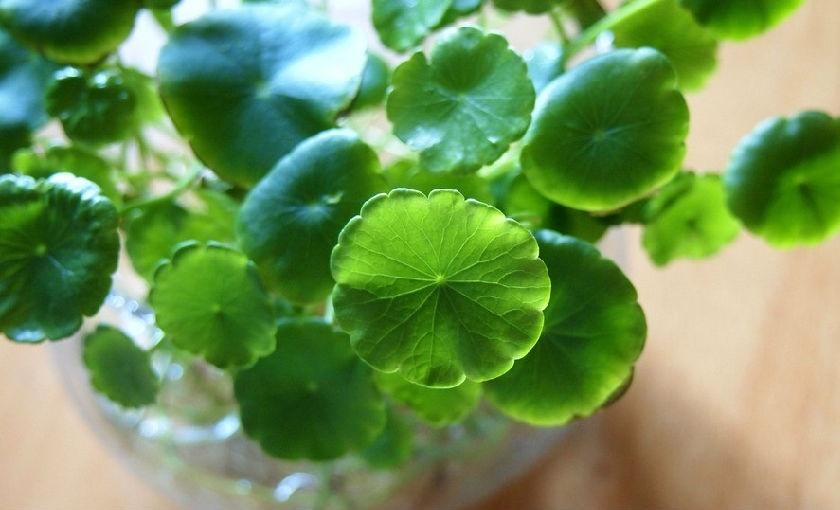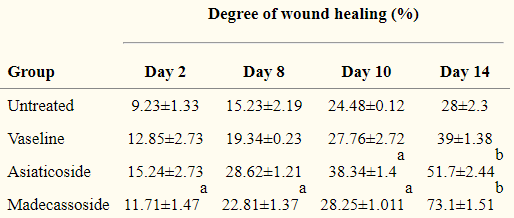1. Madecassoside & Asiaticoside Overview
Madecassoside and asiaticoside are the main active components triterpenoids in Centella asiatica extract. Both of them have been the marker compounds of C. asiatica in Chinese Pharmacopoeia (2015 edition). Madecassoside and asiaticoside benefits for skin differs in some aspects. We will show you the similarities and differences between madecassoside and asiaticoside in skincare.
Madecassoside and asiaticoside have wound-healing properties. According to scientists, madecassoside and asiaticoside can synthesize collagen and stimulate extracellular matrix accumulation. Especially, They can promote type I and type III collagen, thereby increasing dermal reconstruction and wound healing, as well as repairing damaged skin.

| Product Name | CAS Number | INCI Name | |
| Madecassoside | 34540-22-2 | CENTELLA ASIATICA EXTRACT | |
| Asiaticoside | 16830-15-2 | ||
| Product ID | Specification | Minimal Package | Minimal Order Quantity |
| PMQD0803 | 90% Madecassoside | 1KG | 1KG |
| PMQD0806 | 95% Asiaticoside | ||
2. Madecassoside & Asiaticoside Plant Source
Centella asiatica, also named Gotu Kola can be used for food. People in Southeast Asia, South Asia, and South America eat centella asiatica as a vegetable. In Thailand and India, centella asiatica is a good material for making beverages and juices. In Vietnam, peolple eat centella asiatica together with green onions, which has always been a symbol of deliciousness. Centella asiatica is also a commonly used traditional medicinal material. Its medicinal value is recognized by people from all over the world.

3. Madecassoside & Asiaticoside Manufacturer Specifications
90% Madecassoside Manufacturer Specifications
| Items | Specifications |
| Assay | Madecassoside≥90.0% |
| Appearance | White to creamy powder |
| Physical Characteristics | |
| Loss drying | ≤3.0% |
| Ignition residue | <1.0% |
| Heavy Metals | |
| Heavy metals | ≤20ppm |
| As | ≤0.5ppm |
| Pb | ≤0.5ppm |
| Hg | ≤0.05ppm |
| Cd | ≤0.30ppm |
| Cu | ≤5.0ppm |
| Pesticide Residue | |
| BHC | ≤0.1ppm |
| DDT | ≤0.1ppm |
| PCNB | ≤0.1ppm |
| Total Bacterial Count | |
| Total Bacterial Count | ≤1000cfu/g |
| Yeast/moulds | ≤100cfu/g |
| Salmonella | Negative |
| E-Coil | Negative |
95% Asiaticoside Manufacturer Specifications
| Items | Specifications |
| Assay | Asiaticoside≥95.0% |
| Appearance | White powder |
| TLC | Conforms |
| Physical Characteristics | |
| Loss drying | ≤3.0% |
| Ignition residue | <1.0% |
| Heavy Metals | |
| Heavy metals | ≤20ppm |
| As | ≤0.5ppm |
| Pb | ≤0.5ppm |
| Hg | ≤0.05ppm |
| Cd | ≤0.30ppm |
| Cu | ≤5.0ppm |
| Pesticide Residue | |
| BHC | ≤0.2ppm |
| DDT | ≤0.2ppm |
| Aldrin | ≤0.1ppm |
| Total Bacterial Count | |
| Total Bacterial Count | ≤1000cfu/g |
| Yeast/moulds | ≤100cfu/g |
| Salmonella | Negative |
| E-Coil | Negative |
4. Madecassoside & Asiaticoside Manufacturer Flow Chart

5. Madecassoside & Asiaticoside Benefits for Skin
- Madecassoside Skin Benefits
Madecassoside is one of the main terpenoids found in the extract of Centella asiatica, which is natural. It is a plant active ingredient with anti-inflammatory properties. With its proven effectiveness and positive mechanism of action, Madecassoside can relieve sensitive or atopic and psiorias prone skin according to anti-inflammation effect.
A study by La Roche Posay reviewed that anti-aging properties of 0.1% Madecassoside combined with 5% Vitamin C. After 6 months, the result showed a significant improvement of fine lines, wrinkles, firmness, and roughness.
- Asiaticoside Skin Benefits
Asiaticoside promotes the repair of damaged skin, mainly used to remove scars, heal wounds, and reduce wrinkle. In cosmetics formula, it is widely used for soothing skin, anti-aging and anti-wrinkle. Moreover, studies in vitro display that Asiaticoside stimulates production of GAGs and synthesis of collagen I.
6. Madecassoside & Asiaticoside Differences in Skincare
However, asiaticoside and madecassoside have some differences in skincare.
The study indicates that inhibitory effect of Centella asiatica extract on the proliferation of scar fibroblasts is from strong to weak in the order of Madecassic acid> Asiatic acid> Madecassoside> Asiaticoside. That means the wound-healing effect of Madecassoside is more potent than that of Asiaticoside. The following table shows that Madecassoside in wound healing is most significant among the groups.

Table 1. Degree of wound healing of partial-thickness burn wounds treated with asiaticoside and madecassoside.

Table 2. Effects of asiaticoside and madecassoside on THP-1 cell proliferation.
7. Madecassoside & Asiaticoside Dosage and Application
Asiaticoside and madecassoside can be used in different cosmetic formulas, such as cream, essence, mask, lotion and others. The recommended dosage used in cosmetics is from 0.5% to 2.0%.
8. Madecassoside & Asiaticoside Reference Cosmetics Formula
Skin-repair Toner
| Ingredient | Content (%) | Ingredient | Content (%) |
| Asiaticoside | 1.5 | Chamomile extract | 1 |
| Althaea officinalis root extract | 1 | Lavender water | 59.7 |
| Verbena flower water | 10 | Glycerin | 2 |
| Glucolactone | 0.7 | 1,3- Pentanediol | 0.5 |
| Sodium hyaluronate | 0.02 | Fucogel-1 | 0.5 |
| 1,3- Propylene glycol | 7 | Xylitol | 3 |
| Water | Add to 100 | ||
Plamed focuses on natural cosmetic ingredients for more than 10 years. We have founded four subsidiary companies, which respectively develops different kinds of cosmetic raw material. Plamed is a company whose CEO is designated as the first secretary general of Shaanxi Plant Extraction Association.
As a professional Madecassoside & Asiaticoside manufacturer, Plamed have been constantly upgrading the production process. We firmly believe that good Madecassoside & Asiaticoside and good Madecassoside & Asiaticoside price will help customers make good terminal products and help customers win a lasting and broad market.







